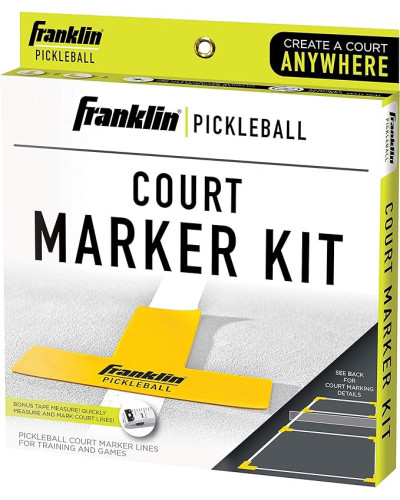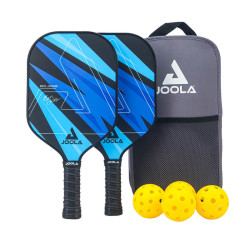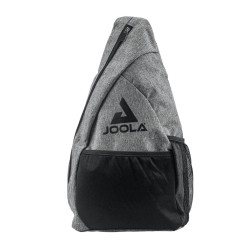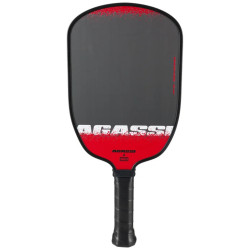
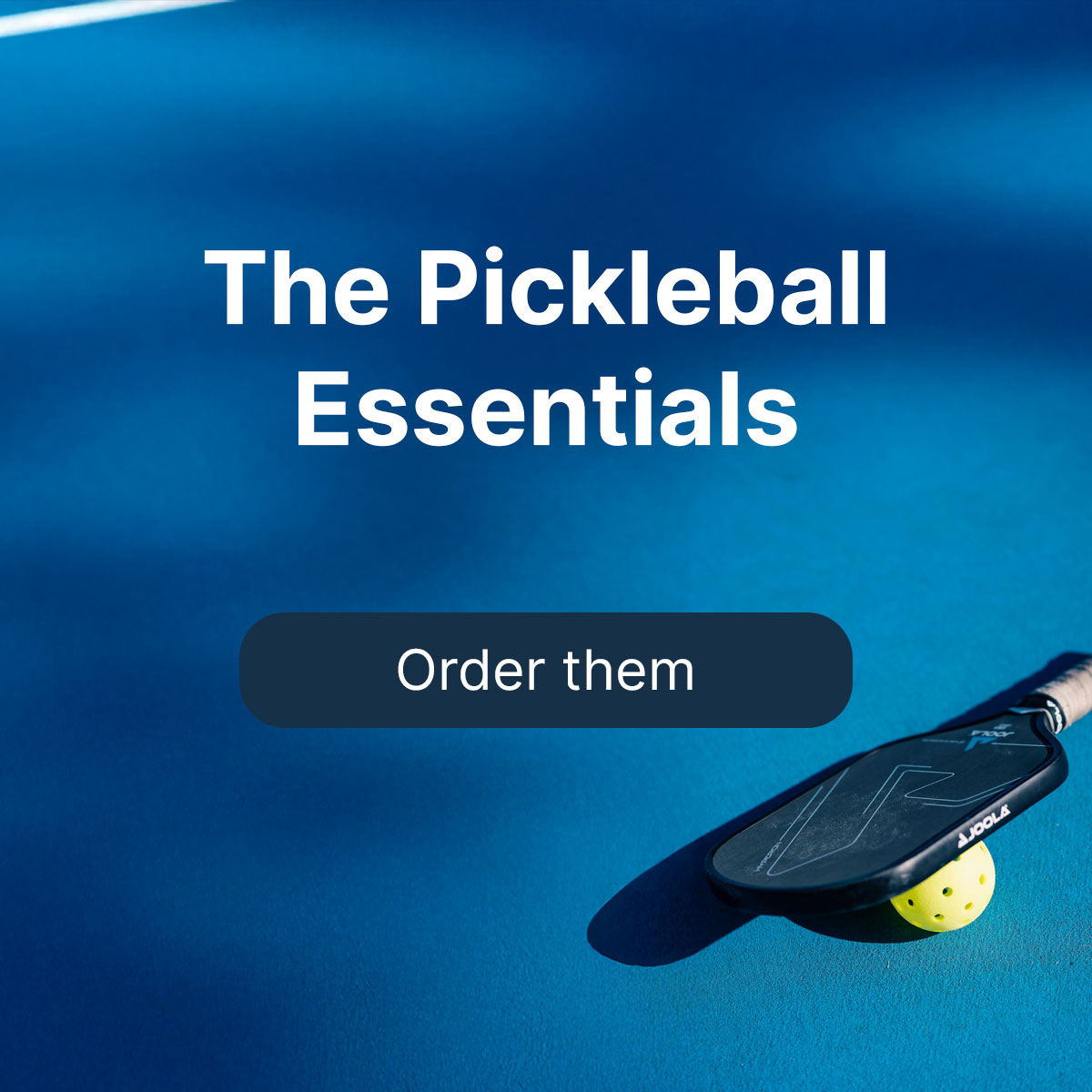
Current Offers
The Best Paddles
The essentials
pickleball: everything you need to know about this booming sport
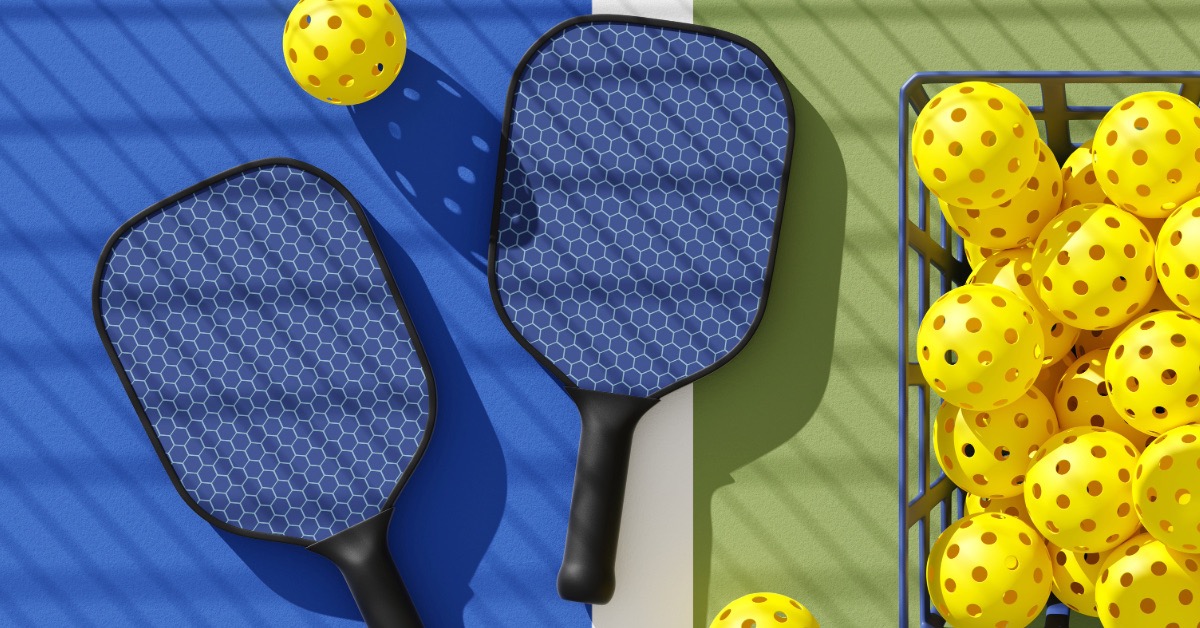
What is Pickleball?
Pickleball is much more than just a racket game: it’s a hybrid, fast-paced, accessible, and addictive sport that combines the best elements of tennis, badminton, and ping-pong. Its goal? To offer a fun, dynamic, and ultra-friendly experience where everyone can enjoy themselves from the very first minutes—whether among friends, family, or in competition.
While tennis takes years to master spin and padel requires a specific placement technique, pickleball can be picked up in just a few exchanges. Its low net, lightweight perforated plastic ball, and specially adapted paddles allow for longer, strategic rallies without the frustration of immediate faults. In short, less frustration and more fun right from the first game.
Another key factor in its success is its total accessibility. Unlike tennis, which requires a large space, specific courts, and sometimes a lengthy learning curve, pickleball can be played almost anywhere:
On a badminton court – just add some floor markings and lower the net.
In a multi-sport hall – a regular gym can easily host several pickleball courts.
Outdoors – on adapted tennis or basketball courts.
In your backyard or parking lot – with a portable net and some adhesive tape.
On a proper pickleball court – increasingly, specialized sports complexes are emerging, featuring dedicated spaces for racket sports where pickleball sits alongside padel and tennis. These modern facilities offer an optimal playing experience with officially sized courts and surfaces designed for quick movements.
It’s a sport perfect for all ages. Whether you’re a child, an adult, or a senior, everyone can play with ease. And unlike tennis or squash, which can heavily strain the joints, pickleball is gentle on the knees, back, and shoulders—so much so that it’s even recommended in some sports rehabilitation programs.
But don’t be fooled by its simplicity. While pickleball is accessible to beginners, it also offers impressive tactical depth for competitive players. With shot spin, placement strategies, and trajectory anticipation, the best players master a range of shots and formidable tactics, making each match unique and thrilling.
And that’s exactly why pickleball is exploding today: it’s the perfect sport to have fun without overthinking, while also offering plenty of room to improve and challenge yourself.
Recreational or competitive, no matter your level, you’ll quickly become hooked.
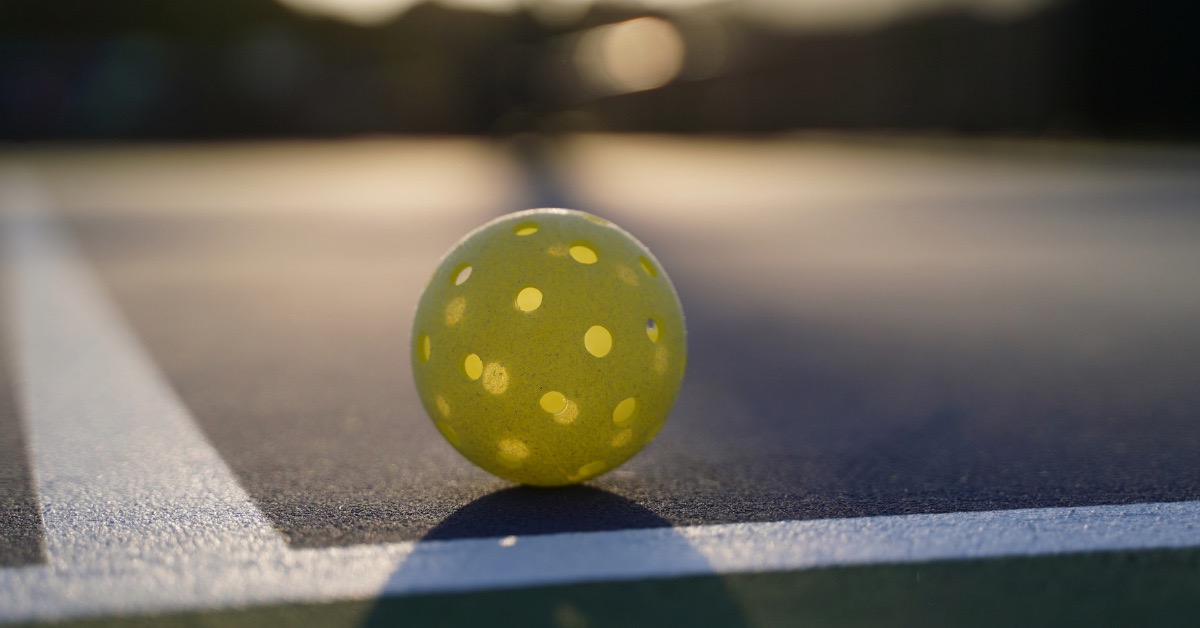
The history of pickleball: origins, evolution and global expansion
The Origins of Pickleball
Pickleball was invented in 1965 on Bainbridge Island, near Seattle, in the state of Washington, USA. This sport was born out of a simple intention—to keep children occupied during summer vacations. Three friends, Joel Pritchard (an American politician), Bill Bell (a businessman), and Barney McCallum, improvised a game using the available resources. They used a badminton court, lowered the net, grabbed wooden paddles, and a perforated plastic ball. Unbeknownst to them, they had just created a sport that would revolutionize the world of racket games.
The name “pickleball” has several supposed origins. The most popular explanation claims that the name comes from the Pritchard family’s dog, named “Pickles,” who used to chase after the ball. Another version suggests that the word “pickle” refers to the “pickle boat,” a term used in rowing to designate a crew composed of rowers from different backgrounds—a perfect analogy for a sport that blends elements of badminton, tennis, and ping-pong.
Structuring and Early Competitions
Although originally just a pastime, pickleball quickly gained popularity. In response to the local enthusiasm, official rules were written in 1972, and the first company dedicated to producing specialized equipment was established. In 1984, the United States Pickleball Association (USAPA) was created to standardize the rules, organize tournaments, and develop the sport on both a national and international scale.
The first official tournament was organized in 1976 in Tukwila, Washington. At that time, the sport was still relatively unknown, but its spread through schools, community centers, and sports complexes helped democratize it.
The Rise of Pickleball in the United States and Worldwide
In the 2000s, pickleball experienced a true boom. Thanks to social media and viral videos showcasing intense and strategic rallies, it attracted an ever-growing number of enthusiasts. Between 2016 and 2022, the number of players in the United States doubled from 2 to 4.8 million. In 2023, that figure exploded to over 36 million players, making it one of the fastest-growing sports in the country.
Canada followed the same trend, and at the same time, Europe began to show interest. In Germany, the United Kingdom, and Spain, the first clubs started to emerge. Major sports brands such as Wilson, HEAD, Joola, and Selkirk are investing in pickleball by developing specialized lines of paddles, balls, and equipment.
The Development of Pickleball in France
In France, pickleball arrived later, but its expansion is rapid today. Introduced mainly by North American expatriates and racket sports enthusiasts, it is beginning to captivate an increasing number of clubs and players.
A major turning point occurred when the French Tennis Federation (FFT) decided to gradually integrate pickleball into its affiliated clubs. This initiative allowed existing facilities to be used for offering pickleball courts to members. Additionally, multi-sport complexes have emerged, combining pickleball, padel, and tennis—a trend that appeals to a wide audience.
The numbers speak for themselves: the number of players in France increases by 30% per year, and more than 1,000 clubs are expected to offer dedicated courts by 2025. This growth can be explained by several factors:
- A sport that is easy to learn and requires no previous experience in racket sports.
- More affordable equipment costs compared to tennis or padel.
- Accessibility for all ages, particularly seniors and children.
- Growing adoption by multi-sport centers and local communities.
Towards Global Recognition
While pickleball was relatively unknown 20 years ago, it is now on track to become a major sport. It is already recognized by several international federations and could eventually be considered as an Olympic discipline.
With its ease of learning, strategic yet friendly nature, and wide accessibility, pickleball has managed to captivate a broad audience. Whether as a recreational game among friends or as a competitive discipline, it is clear that this sport is here to stay.
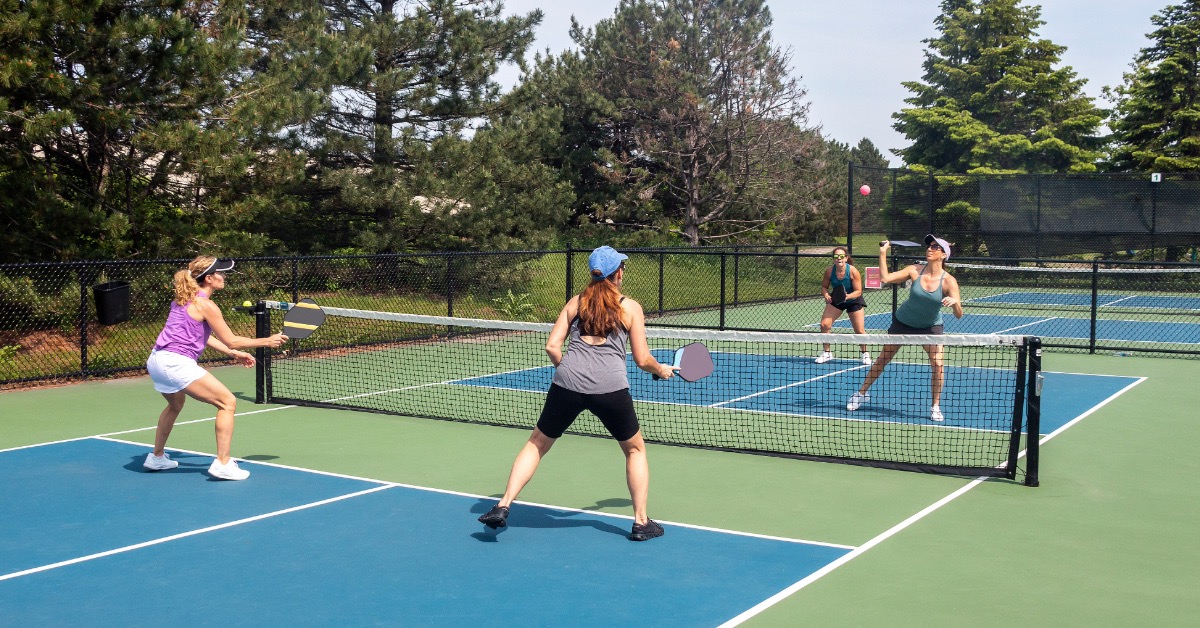
Pickleball rules: a complete guide
Pickleball is a sport distinguished by unique rules that encourage fast, strategic, and accessible gameplay for everyone. Inspired by tennis, badminton, and ping-pong, it can be played in singles or doubles on a specific court using a perforated ball and a specially adapted paddle. Below is a detailed guide to the essential rules for understanding this rapidly growing sport.
General Pickleball Rules
The Court and Equipment
Court Dimensions:
6.10 meters wide by 13.41 meters long—the same size as a doubles badminton court.
The Net:
Positioned at 91.44 cm high in the center and 86.36 cm high on the sides.
The Paddles:
Smaller than tennis rackets, they are made from composite materials, graphite, or polypropylene.
The Balls:
Made of perforated plastic, with variations for indoor or outdoor play.
The Serve
The serve must be performed underhand (a “scoop” stroke below the waist).
The server must have at least one foot behind the baseline.
The serve must be hit diagonally into the opponent’s service court.
The ball must not land in the non-volley zone (commonly known as the “kitchen”).
Only one serve attempt is allowed (except in the case of a let, where the ball touches the net but lands in the correct service area).
The Two-Bounce Rule
A specific rule in pickleball requires the ball to bounce once on each side before a volley is permitted:
After the serve, the receiver must let the ball bounce before returning it.
The server must also wait for a bounce before playing the next shot.
After these two bounces, players may hit the ball either in the air (volley) or after a bounce.
The Non-Volley Zone ("Kitchen")
Located 2.13 meters from the net on each side, this zone prevents players from smashing too close to the net:
Volleys are not allowed in this area.
A player may enter the non-volley zone only after the ball has bounced there.
After hitting a volley, a player's momentum must not carry them into the non-volley zone.
Scoring
Only the serving team (or player) can score points.
A set is generally played to 11 points, with at least a 2-point lead required to win.
In competition, matches are usually best two out of three sets (or best three sets in longer matches).
Rules Specific to Singles Play
Singles Serve
The serve starts from the right side if the server’s score is even and from the left side if it is odd.
The server continues serving as long as they win points.
Movement and Strategy
In singles, the game relies heavily on anticipation and placement:
Use deep, long balls to push your opponent back.
Alternate between cross-court shots and short balls to surprise your opponent.
Use the non-volley zone tactically to disrupt your opponent’s rhythm and regain control of the game.
Rules Specific to Doubles Play
Doubles is the most popular format, requiring coordination and communication.
Doubles Serve
At the beginning of the match, the serving team has only one server.
Subsequently, each team has two serves (one per player).
Rotation and Positioning
The first server starts on the right side.
Once a point is scored, players alternate positions.
When both players lose their service, the serve passes to the opposing team.
Score Announcement
Before each serve, the score is announced using three numbers:
The serving team’s score.
The opposing team’s score.
The server’s number (1 or 2).
Common Faults
Serving outside the diagonal or landing the ball in the non-volley zone.
Failing to observe the two-bounce rule.
Volleying from within the non-volley zone.
Hitting the ball out of the court boundaries.
Pickleball, with its unique rules, offers a dynamic, strategic, and friendly game. The combination of the non-volley zone, the two-bounce rule, and the unique scoring system makes it an accessible yet demanding sport. Whether played in singles or doubles, understanding these rules is essential to master the game and improve your skills.
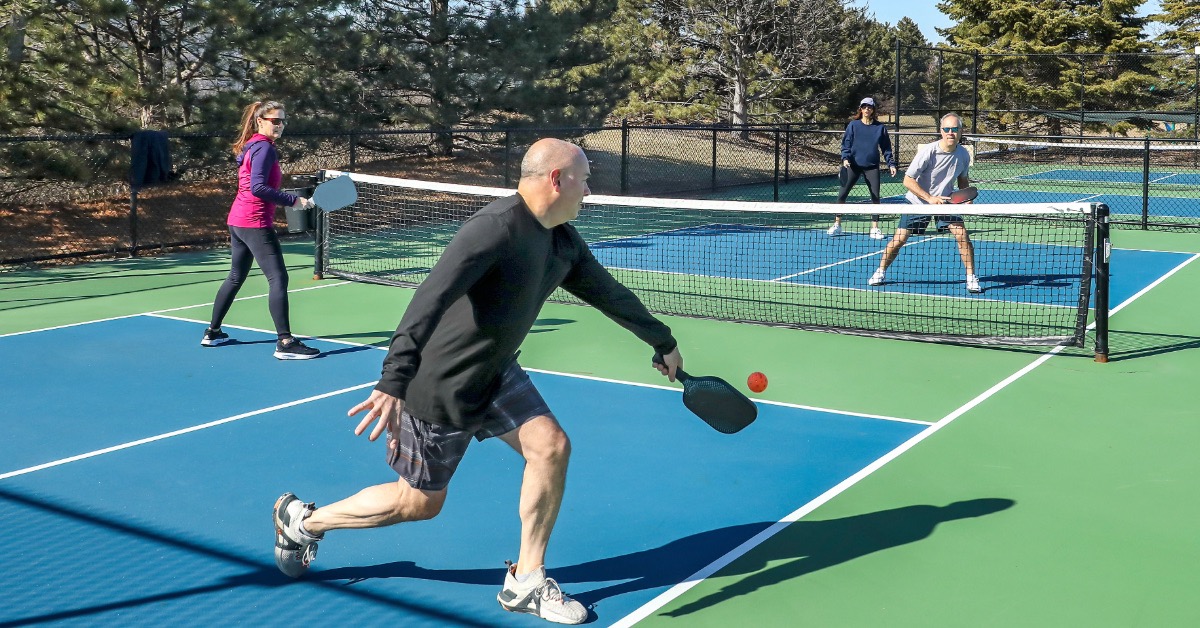
The equipment for pickleball: everything you need to play well
LPickleball is a sport that combines precision, responsiveness, and accessibility. Like any racket sport, choosing the right equipment is essential to optimize performance and prevent injuries. Whether you're a beginner or an experienced player, having quality gear will help you improve and fully enjoy every match. Here’s a detailed guide to help you select the perfect equipment.
Pickleball paddles: the heart of the game
[See all pickleball paddles]
The paddle is the key element of pickleball. Smaller than a tennis racket but larger than a ping-pong paddle, it must be lightweight and easy to handle. Different materials influence power, control, and responsiveness.
Materials: graphite, composite, or polypropylene?
- Composite paddles: Recommended for beginners, offering a good balance between power and control. Easy to handle for a quick learning curve.
- Graphite paddles: Popular among intermediate and advanced players, they provide better precision and responsiveness. They are lightweight and ideal for fast exchanges.
- Polypropylene core paddles: Best for advanced players, they absorb vibrations better and offer a more precise feel.
[Discover our complete selection of pickleball paddles.]
Pickleball balls: indoor or outdoor?
[See all pickleball balls]
Pickleball balls are made of perforated plastic, with designs varying depending on whether they are for indoor or outdoor use.
Two types of balls
- Indoor balls: Lighter, with smaller holes for better precision on smooth gym floors.
- Outdoor balls: Heavier and more durable, with larger holes to better handle wind and hard courts.
Colors and their importance
- Yellow and orange: The most common, offering excellent visibility.
- White or green: Suitable for indoor courts with dark backgrounds.
[Find our full range of pickleball balls.]
The net and court markings
A well-structured pickleball court ensures the best playing experience.
The net: height and available types
- Regulation height: 91 cm at the center, 86 cm at the sides.
- Portable net: Ideal for quick setup and use on temporary courts.
- Fixed net: Best suited for clubs and dedicated facilities.
Court markings
- Adhesive tape: A temporary solution, perfect for converting a badminton court into a pickleball court.
- Temporary paint: Great for multi-sport courts.
- Badminton court lines: Many sports centers already allow pickleball using existing badminton markings.
Shoes and clothing for pickleball
Shoes: an essential element
[See all pickleball shoes]
Quick lateral movements in pickleball require shoes that provide good grip and cushioning.
- Tennis shoes: Excellent for stability and support.
- Padel shoes: Lightweight and designed for surfaces similar to pickleball courts.
- Indoor multi-sport shoes: Ideal for gym play.
Clothing for comfort and mobility
[See our range of pickleball clothing]
Outfits should be lightweight, breathable, and allow full movement.
- Technical t-shirts: Wick away sweat to keep you dry.
- Sports shorts and skirts: Comfortable and designed for quick movements.
- Light jackets and sweatshirts: Perfect for warm-ups and cool-downs.
Essential accessories
- Pickleball bags: Convenient for carrying paddles, balls, and personal items.
- Overgrips: Improve paddle grip and comfort.
- Protective eyewear: Recommended for indoor play and competitive matches.
Having the right equipment is essential for improving in pickleball and fully enjoying the game. Whether it’s paddles, balls, shoes, or nets, every piece of gear contributes to enhancing your performance and comfort.
[Find all the necessary equipment in our store:]
- Pickleball paddles
- Pickleball balls
- Shoes
- Clothing
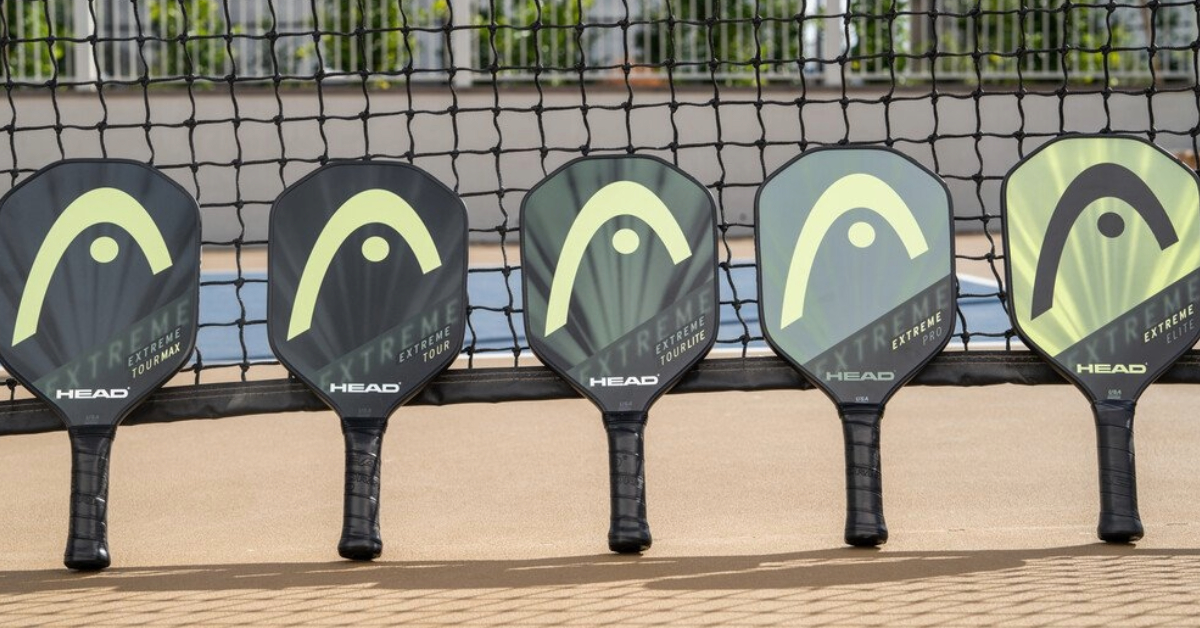
The major pickleball brands: Joola, HEAD, Wilson, and Selkirk
Pickleball is experiencing rapid growth, attracting more and more players worldwide. With this surge in popularity, leading sports brands have developed high-quality equipment to meet the needs of players at all skill levels, from beginners to professionals. Among them, Joola, HEAD, Wilson, and Selkirk stand out for their innovation, expertise, and commitment to the sport’s development. Here’s a detailed overview of these top pickleball brands.
Joola: German precision in pickleball
Joola is a legendary brand in racket sports, particularly known for its expertise in table tennis. Founded in Germany in 1952, it has established itself as a reference in pickleball thanks to its focus on innovation and performance.
Joola’s entry into the pickleball market was marked by strategic collaborations with top players, including Ben Johns, one of the world’s best. The brand has developed a range of paddles designed specifically for competitive play, featuring advanced technologies such as:
- Carbon Friction Surface (CFS): A carbon surface that enhances ball grip and spin.
- Hyperfoam Edge Wall: Injected foam along the paddle edges for greater stability and better weight distribution.
- Ergonomic grip: Designed to maximize comfort and control.
Joola paddles are favored by players seeking a perfect balance between power and control. By leveraging its expertise in composite materials and game analysis, Joola has quickly established itself as a major player in the pickleball industry.
HEAD: Tennis excellence applied to pickleball
HEAD is a world-renowned Austrian brand, primarily known for its tennis and skiing equipment. With its expertise in innovative materials and sports engineering, HEAD quickly became a leading name in pickleball, offering paddles designed for optimal balance between power and maneuverability.
HEAD paddles stand out due to several features:
- Optimized weight and aerodynamics: Enables players to achieve excellent swing speed.
- Comfort Grip System: Reduces vibrations and enhances playing comfort.
- Variety of shapes and sizes: Models suited to different play styles, from power to precision.
HEAD also offers highly durable pickleball balls, ideal for both competitions and training sessions. By combining technology with experience from other sports, HEAD has created high-performance equipment that appeals to beginners and seasoned players alike.
Wilson: Experience and innovation in pickleball
Wilson is an iconic American brand in racket sports. Having been a major name in tennis, badminton, and squash for over a century, Wilson naturally expanded into pickleball with cutting-edge equipment. With its extensive expertise, Wilson designs paddles that combine durability, comfort, and precision, making them a top choice for many players.
Key features of Wilson paddles include:
- PolyCore-X technology: A polypropylene core designed to reduce vibrations and provide optimal control.
- Textured composite surface: Enhances ball grip and spin.
- Lightweight and durable construction: Wilson uses advanced composite materials to create paddles that are both strong and easy to handle.
Wilson also plays a significant role in developing pickleball by organizing events and sponsoring professional tournaments. The brand offers a wide range of accessories, including high-performance balls, carrying bags, and grips for improved paddle handling.
Selkirk: American innovation for top performance
Selkirk is a brand entirely dedicated to pickleball, allowing it to develop equipment specifically designed for the sport. Founded in the United States by the Barnes family, Selkirk quickly became a reference brand thanks to its commitment to innovation and excellence.
Selkirk paddles are known for:
- Carbon fiber construction: Provides increased durability and ultra-precise ball feel.
- X5™ core technology: Enhances responsiveness and shock absorption.
- Advanced customization: Different grip sizes and surface textures to match each player’s needs.
In addition to paddles, Selkirk offers specialized bags, premium grips, and a complete range of accessories to support players at all levels. The brand also sponsors some of the world’s top players, helping to promote pickleball at the highest level.
Which brand should you choose for your pickleball equipment?
The choice of brand largely depends on playing style and personal preferences:
- Joola is perfect for those seeking an ideal balance between power and control, with high-performance models used by professional players.
- HEAD focuses on comfort and weight optimization, making it a great choice for players looking for a blend of maneuverability and power.
- Wilson caters to players who want a durable, precise paddle with excellent shock absorption and touch.
- Selkirk, as a pickleball specialist, offers innovative equipment that is particularly suited to competitive players and those looking for top-tier performance.
With these four leading brands, pickleball players have a wide range of options to equip themselves with high-performance gear tailored to their level and playing style. Whether you’re a beginner or a seasoned competitor, choosing the right brand and equipment is essential for maximizing enjoyment and improving your game.

The major pickleball competitions worldwide and in Europe
Pickleball, experiencing rapid growth, attracts not only amateur players but also high-level competitors. Once seen as just a recreational activity, the sport is now structured around international, national, and regional tournaments, drawing increasing numbers of players and spectators.
Across the world, pickleball tournaments are emerging, ranging from major events to local competitions that allow players of all levels to compete and improve. Europe is also embracing this trend, with growing organization and the emergence of official competitions.
The biggest pickleball competitions worldwide
1. US Open Pickleball Championships
The US Open Pickleball Championships, held annually in Naples, Florida, is one of the most prestigious pickleball events in the world. It attracts thousands of participants and spectators, with categories ranging from amateurs to professionals. This tournament is a true spectacle and plays a crucial role in promoting pickleball in the United States and internationally.
2. PPA Tour (Professional Pickleball Association Tour)
The PPA Tour is the premier professional pickleball circuit. Taking place in various cities across the U.S. throughout the year, it showcases the world’s best players, such as Ben Johns, Anna Leigh Waters, and Jay Devilliers. PPA tournaments offer significant prize money and are widely broadcast, drawing an ever-growing audience.
3. APP Tour (Association of Pickleball Players Tour)
The APP Tour is another major American circuit, but it stands out for its inclusive approach. It welcomes players of all levels, from amateurs to professionals, and hosts tournaments not only in the U.S. but also in other countries. The APP Tour serves as one of the best platforms for aspiring players to reach elite competition and gain recognition.
4. The Pickleball World Championships
The Pickleball World Championships bring together top players from across five continents, making it one of the most prestigious titles to win. It is organized under the authority of the World Pickleball Federation (WPF), which oversees the global development of the sport.
Pickleball competitions in Europe
Europe is in the process of structuring its own competitive circuits to support the sport’s growth. More and more countries are organizing national championships and international tournaments.
1. European Pickleball Championships
This tournament is the flagship event for European pickleball. It brings together the continent’s best players and allows national federations to promote the sport within their respective countries. With increasing participation each year, the European Pickleball Championships is becoming a key reference for competitors looking to test themselves against the European elite.
2. National Open Tournaments in Europe
Several European countries now host open tournaments that welcome international players, including:
- British Open Pickleball (United Kingdom)
- Spanish Open Pickleball (Spain)
- German Open Pickleball (Germany)
- Italian Pickleball Championships (Italy)
These tournaments provide players with unique opportunities to face international opponents while also serving as a measure of pickleball’s evolving level across Europe.
3. Emerging national circuits
Many countries, including France, Germany, Spain, and the Netherlands, are developing their own national championships with a growing number of affiliated clubs and participants. These circuits are often supported by national federations and are receiving increasing media coverage.
The future of pickleball competitions: Exponential growth
Pickleball is rapidly establishing itself as a major competitive sport, and this evolution is set to continue in the coming years.
Why is pickleball gaining such momentum?
- A sport accessible to everyone—youth, adults, seniors, athletes, or beginners.
- Well-organized and attractive tournaments with increasing prize money and media coverage.
- A rapidly expanding audience—pickleball’s popularity is extending beyond the U.S.
It is highly likely that pickleball will be included in new international multi-sport competitions and that its European professional circuit will expand significantly. The creation of a global championship series featuring the world’s top players could very well be the next step!
With the increasing number of events and competitions, pickleball is solidifying its status as a legitimate sport, appealing to both casual players and elite athletes.

The greatest current pickleball players (men & women)
Pickleball continues to grow in popularity, and with it, exceptional players are emerging on the international stage. Whether through their technique, power, strategic vision, or influence on the sport’s development, these athletes have become key figures. Here are the men and women who dominate pickleball courts and inspire the next generation.
Top Male Pickleball Players
Ben Johns – The master strategist
If you follow pickleball, you can’t miss Ben Johns. The American player is one of the most dominant figures in the sport’s history. Highly versatile and strategic, he excels in both singles and doubles. His game is built on impeccable shot placement, exceptional precision, and the ability to adapt to opponents in real time.
Johns isn’t just winning—he’s revolutionizing the game. He partnered with Joola to develop high-end paddles designed for professional-level play. With over 80 titles on the PPA Tour, he continues to dominate major tournaments like the US Open Pickleball Championships and the Tournament of Champions.
Tyson McGuffin – The fierce competitor
Tyson McGuffin is known for his raw power and intense athleticism. A former wrestler, he has successfully transitioned his physical conditioning and competitive mindset to pickleball. His aggressive, high-energy playing style makes him a formidable opponent.
Beyond competition, McGuffin is an ambassador for the sport. He hosts pickleball clinics, shares technical insights, and inspires players worldwide. His energy and charisma make him one of pickleball’s most popular personalities.
Jay Devilliers – The "Flying Frenchman"
France has a top pickleball representative in Jay Devilliers. Known as the "Flying Frenchman," he is one of the few European players to have made a significant impact on the U.S. circuit. His explosive game and endurance make him a serious contender.
Devilliers is not only a global pickleball star but also a key figure in promoting the sport in France and Europe. His experience on the international scene and his role as a pioneer make him a crucial force for the sport’s growth across the continent.
Chris Haworth – The rising star
Part of the new generation challenging the established hierarchy, Chris Haworth successfully transitioned from tennis to pickleball. His ultra-aggressive and unpredictable playing style has already earned him nine gold medals on the APP and PPA Tours in 2024, proving that he’s a force to be reckoned with in the coming years.
Top Female Pickleball Players
Anna Leigh Waters – The teenage prodigy
At just 18 years old, Anna Leigh Waters has already become a dominant force in women’s pickleball. Her game is explosive, fast, and aggressive. She combines powerful strokes with remarkable adaptability. She also excels in mixed doubles, forming highly effective partnerships.
Waters represents the future of pickleball, showing that the sport now attracts elite-level athletes from a young age.
Catherine Parenteau – The technical master
Originally from Canada, Catherine Parenteau is one of the most skilled and feared players on the circuit. A former tennis player, she has successfully adapted her game to pickleball. Her strengths include outstanding shot precision and an exceptional tactical mind.
Parenteau is also actively involved in promoting pickleball in North America, helping develop young players and ensuring the sport’s growth beyond just her on-court performances.
Simone Jardim – The legendary champion
Simone Jardim has left a lasting mark on pickleball history by winning four consecutive US Open titles. Originally from Brazil, she dominated the women’s game between 2016 and 2020. Her experience and deep understanding of the game still make her a formidable competitor today.
Lucy Kovalova – The powerhouse
With a background in tennis, Lucy Kovalova is known for her powerful and precise shots. She thrives in doubles, where her aggressive playing style makes her one of the most effective competitors in the game.
How These Champions Are Shaping Pickleball
These players are more than just elite athletes—they are driving the sport’s growth in several ways:
- Expanding pickleball’s audience: Their performances and media presence attract millions of new fans.
- Influencing equipment innovation: Collaborations with brands like Joola, HEAD, Selkirk, and Wilson are pushing paddle technology forward.
- Training the next generation: Through clinics and coaching programs, they help develop young talent.
With pickleball still evolving rapidly, new talents continue to emerge, challenging the top players. The sport has never been more competitive, and its future looks incredibly exciting.
Major Pickleball Brands
- Joola: Industry leader, sponsoring top players.
- HEAD: Innovator in pickleball technology.
- Selkirk: High-end paddles favored by professionals.
- Wilson: Trusted brand in racket sports.
Top Pickleball Tournaments & Players to Watch
Biggest tournaments
- US Open Pickleball Championships – The premier event in the U.S.
- PPA Tour – The professional circuit featuring the world’s best players.
- European Pickleball Championships – The top tournament in Europe.
Players to watch
- Ben Johns – The greatest pickleball player of his generation.
- Anna Leigh Waters – The rising star of women’s pickleball.
- Tyson McGuffin – A media sensation and fierce competitor.
- Jay Devilliers – France’s top international pickleball representative.
The Future of Pickleball: More Growth Ahead
Pickleball is booming, and its expansion is just beginning. The sport’s accessibility, fun, and addictive nature are drawing more players of all ages.
🚀 Join the pickleball community and start playing today!

